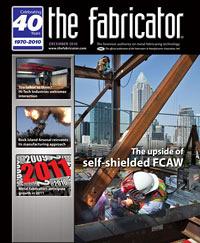Senior Web Developer
- FMA
- The Fabricator
- FABTECH
- Canadian Metalworking
Categories
- Additive Manufacturing
- Aluminum Welding
- Arc Welding
- Assembly and Joining
- Automation and Robotics
- Bending and Forming
- Consumables
- Cutting and Weld Prep
- Electric Vehicles
- En Español
- Finishing
- Hydroforming
- Laser Cutting
- Laser Welding
- Machining
- Manufacturing Software
- Materials Handling
- Metals/Materials
- Oxyfuel Cutting
- Plasma Cutting
- Power Tools
- Punching and Other Holemaking
- Roll Forming
- Safety
- Sawing
- Shearing
- Shop Management
- Testing and Measuring
- Tube and Pipe Fabrication
- Tube and Pipe Production
- Waterjet Cutting
Industry Directory
Webcasts
Podcasts
FAB 40
Advertise
Subscribe
Account Login
Search
11 ways to increase your job shop's online presence
How to maximize your Web site's effectiveness
- By Jason Bartholme
- December 2, 2010
- Article
- Shop Management
Today most job shops treat their Web site like a telephone listing: They have one, and that’s about it. They are doing nothing to attract visitors to the site. However, with a little knowledge about Web sites and search engines, that can change. The following tips and techniques will give your Web site a push in the right direction.
1. Claim Your Address in Google Places
Once you launch your Web site, one of the first things you should do to increase your online presence is to get listed in Google Places at http://www.google.com/places. The listing is free, and it’s a surefire way to have the Web site indexed in the Google search engine. Google Places asks for the following information:
- Physical address
- Web site URL
- Business description
- Business categories
- Hours of operation
- Payment options
- Photos
- Videos
The last four items are optional, but they help to complete your profile when someone views your site details in a local search or as a business location on Google Maps.
2. Put Your Address on All Web Pages
Search engines are continuously evolving to provide relevant results for users. Providing a physical address on Web pages tells the search engine the geographic location the Web site is associated with. If you put Rockford, Ill., on your Web site as the location of your fabricating shop, the search engine is more likely to include your site in search results when a user searches for something like “Rockford metal fabricating.” Be sure to provide your shop’s phone number and physical address on each Web page as well for use by search engines and visitors.
3. Get Listed in Niche Directories
A person looking for a particular service or product might use a niche directory—one that focuses on a specific topic. For example, a real estate directory is focused on connecting users with real estate-related products and services, such as finding a Realtor® and purchasing a property. The same idea can be applied to the metal fabricating industry. Here are four niche directories that offer free listings:
- http://www.thefabricator.com/directory/
- http://www.macraesbluebook.com/GetListed/get-listed.cfm
- http://promoteyourbusiness.thomasnet.com/free_listing.html
- http://www.motionnet.com/cgi-bin/submit.exe?action=submit
4. Ramp up Social Media Efforts
In the last few years, social media has transcended the tech-savvy folks and become accessible to the general Internet audience. Your job shop should take advantage of social media because it can be a viable replacement for a blog. You can create business accounts on Facebook and Twitter to post news, events, and even promotions. Web services such as HootSuite, http://www.hootsuite.com, allow users to post to multiple social media accounts at once. Posts also can be “future dated,” so you can write multiple posts and they will appear in your accounts with regularity.
A popular trend for companies is to place small, square icons in their Web sites that link to the respective social media accounts so site visitors can become friends or followers. They typically are placed in the top right area or footer of a Web site. These icons are readily available from the social Web sites or from an image search.
5. Make Page Titles Search Engine-Friendly
Search engine marketers agree that well-written titles strongly influence search engine rankings. When a user gets a list of results from a search engine, the title of each listing is usually the title tag of the target Web page. For example, in a search of MIG welding (see http://www. google.com/search?q=mig+welding), Google bolds the searched term in the title, content, and URL.
This exemplifies the importance of relevant keywords in titles and content. An optimal home page title for the Web page should include the business name, primary process/service, and city and state (for example, ABC Bending Inc. – Rotary Bending – Rockford, IL).
6. Post Press Releases on the Web Site
Businesses were using press releases as a marketing tool long before the Internet. They are a proven distribution method to get your news out to the public. However, sending offline press releases can be an expensive process. Online press releases, however, can be distributed quickly and at little to no cost.
Free press release distribution Web sites (see http://www.avangate.com/articles/press-release-distribution_ 69.htm) make your release visible to their audiences. Paid press release distribution sites (see http://blog.uprinting. com/top-10-paid-press-release-distribution-sites/), such as Reuters, AP, and local and national news outlets, will get your release in front of a wider audience.
Post your press release on your Web site first, then submit it for distribution. This way, Google should see your content as the original. Google has a tendency to discount duplicate content; as a result, subsequent instances of the same release on other Web sites always will appear below the original Web site in Internet searches.
7. Increase Inbound Links
Increasing inbound links is an off-page optimization technique: Web site A provides a link to Web site B without requiring Web site B to link back. The inbound link is another search engine ranking factor that helps influence a Web site’s overall relevancy.
The links can come from people linking from discussion forums, social media sites, other Web sites, article directories, or Web directories, to name a few. You can actually get more than 50 inbound links with minimal effort (see http://www.jasonbartholme.com/how-to-use-the-firefox-add-on-imacros-to-build-over-50-one-way-links/).
8. Update Content Regularly
A familiar adage in the search engine optimization community is “Content is king.” Fresh content is a tried-and-true method to keep the search engines—and Web site visitors—interested in your site.
If a search engine indexer keeps visiting the page and the page content does not change, it will visit the page less frequently. This can translate to less relevance for the Web site, which means the site will not show up as favorably in the search engine results.
9. Get Listed in Local Directories
Once you’ve listed your site with Google Places, the next step in increasing relevance is to submit it to local directories. These directories use geographic location as a factor when returning search results. A great, and relevant, example is http://www.yellowpages.com.
These types of directories are high-traffic sites, so it makes sense to have your Web site listed in them. Although there are many local directories, many of the major directories use data from the same source: InfoUSA.
The InfoUSA Web site claims that its data powers 85 percent of online directory searches and 90 percent of in-car navigation. Your business will benefit from being found by GPS devices and being listed in InfoUSA-powered local directories. It is free to add a business to the InfoUSA database (see http://dbupdate.infousa.com/db update/index.html)
10. Register Your Web Site With Google’s Webmaster Tools
Google offers a wealth of information about a registered Web site through its free Webmaster Tools service (see https://www.google.com/webmasters/). It is a collection of configurations and reports based on the information Google has about a Web site.
Once you sign up, you’ll need to verify your site by placing a piece of code on the home page or adding a blank Web page with a specific file name. Google will confirm ownership immediately, but it will take a few days or weeks for Web site statistics to display with data.
The reports will tell you what people are searching for when they come to your site. This can influence how you create future content. For example, if people are searching for “press brake dies” and that is a relevant term to your Web site, adding a page to your site just about press brake dies and how they relate to your business has the potential to increase search engine traffic to the site.
11. Make Sure the Home Page Has Actual Content
Years ago the Web design trend was to have an eye-catching animation on the home page, then a link to the actual content. It may be visually appealing to some people, but ultimately it does not help search engine relevance if your home page consists only of a Flash animation.
The animation page doesn’t have any search engine-readable content, so the search engine doesn’t know what the site is about and may not be able to follow Web links that go into the site itself. Search engine indexers are called spiders because they start on a page and “crawl” the links on a page until they can’t anymore or are directed to another domain. If a spider does not have anything to start with on the home page, it will have difficulty crawling the rest of the site.
These are just a few of the low-cost methods for job shops to increase their Web site’s presence and relevance online. Building relevance is an ongoing process, and it sometimes takes time to see tangible results. However, making your Web site favorable to users and search engines is a great stride toward more visitors and sales.
About the Author

Jason Bartholme
FMA Communications Inc.
833 Featherstone Road
Rockford, IL 61107
815-227-8283
subscribe now

The Fabricator is North America's leading magazine for the metal forming and fabricating industry. The magazine delivers the news, technical articles, and case histories that enable fabricators to do their jobs more efficiently. The Fabricator has served the industry since 1970.
start your free subscription- Stay connected from anywhere

Easily access valuable industry resources now with full access to the digital edition of The Fabricator.

Easily access valuable industry resources now with full access to the digital edition of The Welder.

Easily access valuable industry resources now with full access to the digital edition of The Tube and Pipe Journal.
- Podcasting
- Podcast:
- The Fabricator Podcast
- Published:
- 04/16/2024
- Running Time:
- 63:29
In this episode of The Fabricator Podcast, Caleb Chamberlain, co-founder and CEO of OSH Cut, discusses his company’s...
- Trending Articles
AI, machine learning, and the future of metal fabrication

Employee ownership: The best way to ensure engagement

Steel industry reacts to Nucor’s new weekly published HRC price

How to set a press brake backgauge manually

Capturing, recording equipment inspection data for FMEA

- Industry Events
16th Annual Safety Conference
- April 30 - May 1, 2024
- Elgin,
Pipe and Tube Conference
- May 21 - 22, 2024
- Omaha, NE
World-Class Roll Forming Workshop
- June 5 - 6, 2024
- Louisville, KY
Advanced Laser Application Workshop
- June 25 - 27, 2024
- Novi, MI



























